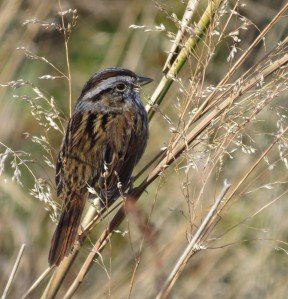The other day, the American Birding Association (ABA) Blog posted an overview to the first part of this year’s American Ornithologists’ Union (AOU) Checklist proposal (which can be found here http://blog.aba.org/2014/12/2015-aou-check-list-proposals-part-1.html). As usual, there were revisions to the family organizations (Parrots, this year), a genus reassignment (American Tree Sparrow), and multiple new splits. The splits included some reasonably predictable ones–Trindade from Herald Petrel, and Rosalia from LeConte’s Thrasher. However, for every split for which a reasonably measured argument can be made, it seems that one split that is more abstract is proposed. This time around, that split goes to the Painted Bunting.
Painted Buntings north of Mexico can be divided into two subspecies. A western subspecies that breeds in brushy areas of the southern Great Plains, and an eastern subspecies that breeds primarily in the coastal southeast. They are likely inseparable in the field, with the primary differences being moult timing and wintering range.
The Painted Bunting is a species whose proposed split is probably less about a biological difference in populations, and more about ornithology and conservations’ politics. The ABA Blog notes that the split proposal suggests treatment of the two populations as separate species as a way to create a more favorable environment for conservation of the eastern subspecies, which is relatively uncommon and declining. I have had long-discussions with other birders around my age, in which we have both questioned the way that the AOU seems to be deciding which populations of birds deserve full-species recognition. I at least, am not willing to hold anyone at fault for attempting to help a population of creatures that is threatened, but I wonder if the best way to do this is to elevate threatened populations to species status. I am of the opinion that the current trend of elevating many many populations of birds to full species status in order to make conservation funds reach them more easily, or because of differences in mitochondrial DNA that do not translate into field identification is diluting the definition of a species.
In the cases of elevating populations for genetic differences, moult-timing differences etc, the picture is much more complicated. But in the case of raising populations for the purpose of conserving them more easily and effectively, I think that there is a solution that will preserve the vitality of the species definition and protect the species–and it does not come from the AOU at all. I think the solution must come from the governments charged with protecting the populations. The governments must have the ability to recognize populations which are locally threatened and maybe not a full species, and offer them the same kind of protection on the basis that they are a locally significant part of the flora and fauna.
I understand that, until and unless this happens, there will, necessarily, have to be other ways of protecting these populations, and that it is, by some, considered valid to use species recognition as a way of doing this. I don’t have any solutions to this “problem”, but I do think it should be noted that this olution has ramifications for the science of taxonomy and genetics. Just some food for thought…

